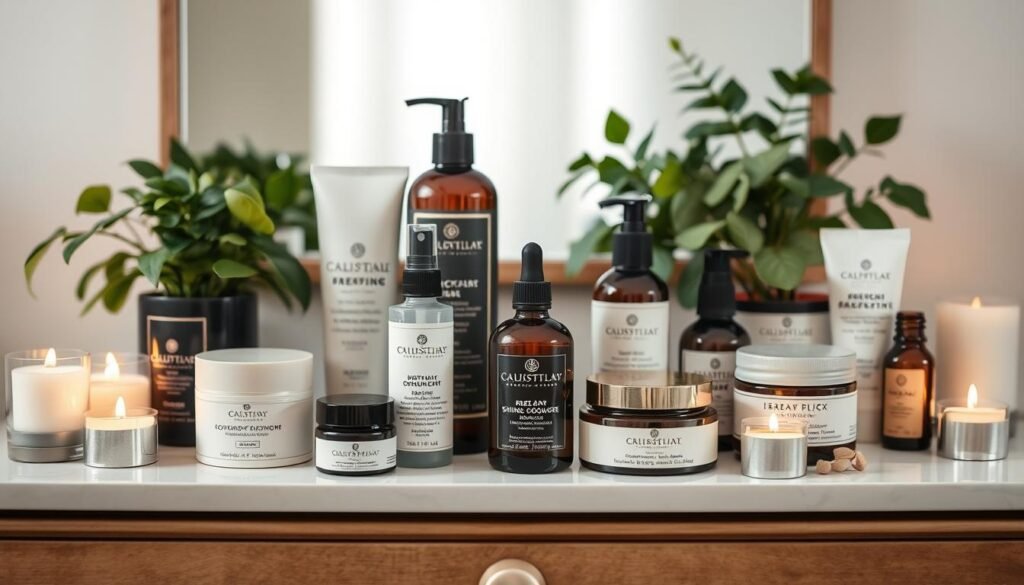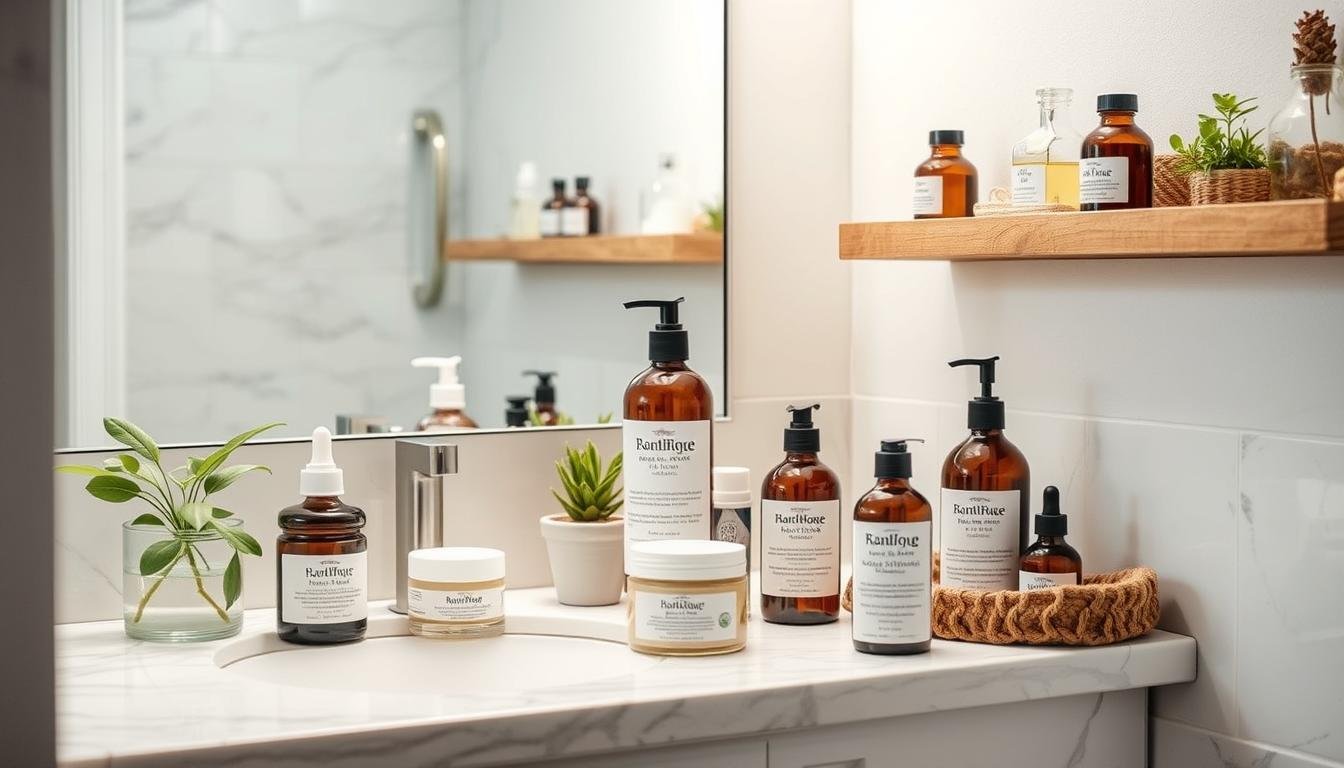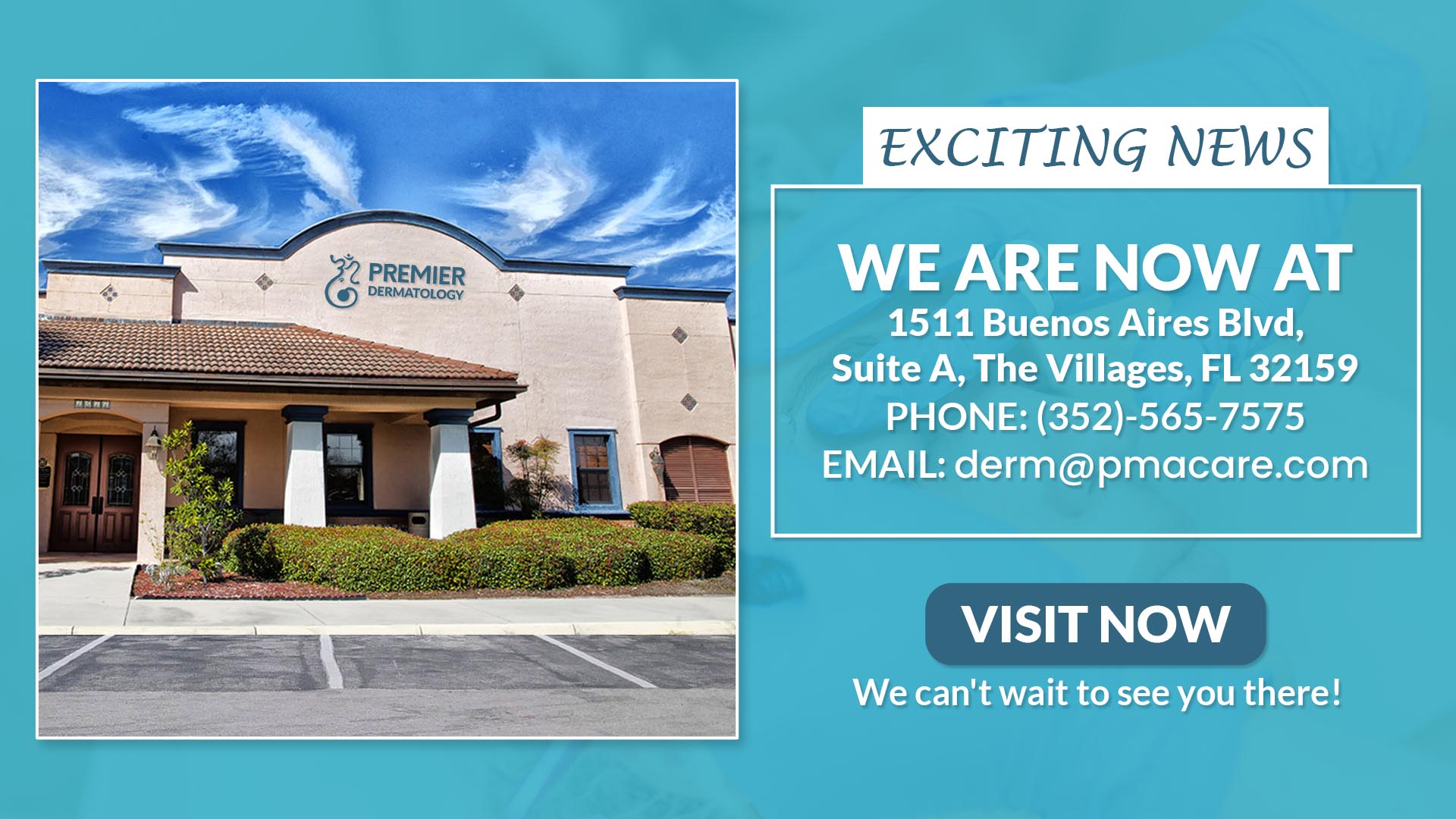Shingles can feel like an unwelcome guest, bringing painful blisters and the risk of lasting scars. It’s a viral infection that affects about 1 million people in the U.S. each year. We need to pay attention and understand it well.
Learning about shingles is our first step. Knowing how it develops and affects our skin is key to avoiding long-term problems. The varicella-zoster virus, which causes shingles, can leave scars that remind us of its intense impact.
Early action is vital. Quick medical care and the right treatment can greatly lower the chance of scarring. It also helps reduce the virus’s overall effect on our health.
Key Takeaways
- Shingles is a viral infection affecting 1 million Americans annually
- Early medical intervention can prevent extensive skin scarring
- Understanding the virus helps in effective management
- Treatment within 72 hours can reduce symptom severity
- Proper care can minimize long-term complications
Understanding Shingles and Their Impact on Skin
Shingles is a viral condition caused by the varicella-zoster virus, the same virus that causes chickenpox. It can cause a lot of pain and affect a person’s health and happiness.
What Causes Shingles
The varicella-zoster virus stays hidden in nerve cells after chickenpox. Years later, it can wake up, usually when the immune system is weak. Things that can trigger it include:
- Being over 50 years old
- Stress
- A weak immune system
- Certain treatments
Initial Signs and Symptoms
Before the rash shows up, shingles has warning signs. People might feel:
- Burning or tingling
- Very sensitive skin
- Pain on one side of the body
- Itching that can be mild or severe
The Connection to Chickenpox
Anyone who had chickenpox has the varicella-zoster virus in their nerves. It can stay there for years before causing shingles.
“One in three people in the US will develop shingles in their lifetime, highlighting the virus’s persistent nature.” – Medical Research Institute
| Age Group | Shingles Risk | Potential Complications |
|---|---|---|
| Under 40 | Low | Minimal |
| 40-50 | Moderate | Occasional nerve pain |
| Over 50 | High | Increased risk of chronic pain |
Knowing how the varicella-zoster virus works helps people spot shingles symptoms early. This way, they can get medical help quickly.
The Formation Process of Shingle Scars
Shingle scars form when the Varicella-Zoster Virus affects skin healing. The first sign is a painful rash that turns into blisters along nerve paths.
The scar formation process has several key stages:
- Initial viral outbreak affecting nerve regions
- Blister formation with possible skin inflammation
- Natural crusting and healing process
- Potential scar tissue development
Our skin’s healing process is key in scar formation. When shingles blisters dry and crust, the body starts a complex repair. About 10-20% of people with shingles may see more noticeable scars.
Skin healing is not just about closure, but about restoration and protection.
Many factors can affect scar development:
- Age of the patient
- Severity of the viral infection
- Individual immune response
- Proper wound care during healing
Up to 18% of patients might get permanent depressed scars. About 40% of facial cases are affected. People over 50 are at higher risk due to a weaker immune system.
Knowing how scars form helps us protect our skin during and after shingles.
Early Warning Signs and Prevention Methods
Shingles is a painful condition that affects many people. Knowing the early signs and how to prevent it is key to managing it well.
About 1 in 3 adults will get shingles at some point. It’s important to prevent it. By knowing the risk factors and taking steps early, you can lower your risk.
Identifying Risk Factors
There are several risk factors for shingles:
- Age over 50 years old
- Weakened immune system
- History of chickenpox
- Chronic stress
- Certain medical conditions
Preventive Measures
Here are ways to lower your risk:
- Maintain a healthy immune system
- Manage stress levels
- Practice good nutrition
- Get regular medical check-ups
Vaccination Options
Vaccination is the best way to prevent shingles. The Shingrix vaccine is over 90% effective.
| Vaccine Type | Effectiveness | Recommended Age |
|---|---|---|
| Shingrix | 90%+ | 50 and older |
*”Prevention is always better than cure, specially with shingles.”*
By knowing the risks, taking preventive steps, and getting vaccinated, we can greatly reduce our chance of getting shingles. This helps avoid its long-term complications.
Immediate Care for Shingles Rash
When you get a shingles rash, it’s important to act fast. This helps manage pain and avoid serious problems. Our guide will show you the first steps to treat the rash and care for blisters.
The first 72 hours are very important. Doctors say to start antiviral meds quickly. This can make symptoms less severe and shorten the outbreak.
- Keep the rash clean and dry
- Use cool compresses to soothe irritation
- Avoid scratching or breaking blisters
- Cover the rash with loose, breathable bandages
Managing pain is key in treating shingles. You can use over-the-counter NSAIDs like ibuprofen for pain. If the pain is too much, your doctor might give you stronger meds.
“Early intervention is the most effective strategy in managing shingles and minimizing possible complications.”
Blister care is also important. Blisters usually scab over in 7 to 10 days. Here’s what to do:
- Protect the affected area from more irritation
- Wash hands before and after touching the rash
- Change bandages every day
- Wash clothes in hot water
| Treatment Stage | Recommended Actions | Duration |
|---|---|---|
| Initial Symptoms | Start Antiviral Medication | Within 72 hours |
| Rash Development | Pain Management | 2-4 weeks |
| Blister Healing | Careful Wound Care | 7-10 days |
People with weak immune systems or over 50 should see a doctor fast. The right treatment can lessen pain and stop long-term problems.
Natural Remedies for Managing Shingle Scars
Healing shingle scars needs a mix of natural treatments and good skin care. We look at natural ways to help skin heal and lessen scars.

Vitamin E Applications for Skin Healing
Vitamin E is a top natural scar treatment. Studies show it can make skin smoother and scars less noticeable. Doctors say to use pure vitamin E oil on scars to help skin grow back.
- Pure vitamin E oil application
- Gentle massage into affected areas
- Consistent daily treatment
Essential Oils and Their Therapeutic Benefits
Essential oils are great for scar treatment. Oils like lavender and tea tree help skin heal. Mix them with a carrier oil to lessen scars and aid in skin recovery.
| Essential Oil | Skin Benefits | Application Method |
|---|---|---|
| Lavender | Reduces inflammation | Diluted topical application |
| Tea Tree | Antiseptic properties | Gentle massage |
| Frankincense | Promotes skin regeneration | Mixed with carrier oil |
Dietary Recommendations for Skin Health
What we eat affects our skin. The Dietary Guidelines for Americans 2020–2025 suggest eating a variety of foods. These foods help our immune system and skin repair.
“Nutrition is the foundation of healing and skin recovery.” – Dermatology Research Institute
Key foods to eat more of include:
- Fruits and vegetables
- Omega-3 rich foods
- Foods high in vitamins C and E
- Lean proteins
- Whole grains
Using these natural remedies can help skin heal and reduce shingle scar effects.
Medical Treatments Available for Scar Reduction
Many medical treatments can help reduce the look of shingle scars. Our approach includes several strategies to improve skin texture and aid in healing.
Prescription medications are key in managing shingle scars. Dermatologists often suggest special creams and ointments to lessen scarring. These can include:
- Steroid-based creams to reduce inflammation
- Silicone-based ointments for skin regeneration
- Prescription-strength vitamin E treatments
Corticosteroid injections are also effective for scar reduction. Research shows these treatments can flatten scars in 50-75% of cases. The process involves several sessions, with breaks to see how the body reacts.
“Effective scar management requires a personalized medical approach tailored to individual skin characteristics.” – Dermatology Research Institute
There are also advanced medical options beyond creams and ointments. Patients can consider:
- Laser resurfacing (60-80% effectiveness)
- Microneedling to stimulate collagen production
- Platelet-rich plasma (PRP) therapy
Each treatment has its own benefits and risks. Talking to a healthcare professional is important to find the best option for your scar reduction needs.
Professional Interventions and Clinical Solutions
When shingles scars don’t go away or are hard to treat, experts in dermatology have advanced solutions. We use new treatments that focus on scars. These methods are designed to work well on scarring.
Laser therapy is a top-notch dermatology treatment for tough shingles scars. It uses precise methods to make skin look better.
Laser Therapy Options
Today’s laser therapy offers many ways to fix scars. We use various lasers to tackle different scar types:
- Fractional CO2 lasers for deep scar remodeling
- Pulsed dye lasers to reduce redness
- Erbium lasers for surface-level scar refinement
Dermatological Procedures
There are more treatments beyond lasers:
| Procedure | Primary Purpose | Typical Duration |
|---|---|---|
| Microneedling | Collagen stimulation | 30-60 minutes |
| Chemical Peels | Skin resurfacing | 45-90 minutes |
| Dermabrasion | Scar smoothing | 30-90 minutes |
Surgical Alternatives
In serious cases, surgery might be needed. Our experts look at each case to find the best solution.
*”Each scar tells a story, and our goal is to help you heal both physically and emotionally.”*
It’s important to talk to a dermatologist. They can help find the best treatment for your shingles scar.
Aftercare and Maintenance Guidelines
Effective scar aftercare is key for managing the healing process after a shingles outbreak. Our guide will help you through the important steps of skin maintenance and recovery.
The first step in shingles scar aftercare is protecting the affected skin. Proper wound care from trusted medical sources can greatly improve healing.
- Clean the rash daily with a fragrance-free cleanser
- Apply a thin layer of pure petroleum jelly
- Use cool, damp compresses to relieve itching
- Wear loose, natural fiber clothing
For the best skin maintenance, consider these extra strategies:
- Apply topical lidocaine up to four times daily for pain relief
- Use calamine lotion after blisters have scabbed
- Keep the area moisturized with vitamin-rich creams
“Patience is key in the healing process – complete recovery can take several weeks.”
Our healing process recommendations include avoiding harsh skincare products and protecting the area from direct sunlight. Dermatologists suggest consulting a professional if symptoms persist or scarring appears severe.
Remember, up to 30% of shingles patients may experience hyperpigmentation or scarring. So, diligent aftercare is essential for the best skin recovery.
Tips for Preventing Further Scarring
Protecting your skin after a shingles outbreak is key. We’ll show you how to prevent scarring and help your skin heal. Follow our guide for a skincare routine that works.
After shingles, your skin needs extra care. Dermatologists say a good skincare routine is vital. It helps your skin heal and stay protected.
Daily Skin Care Routine
For scar prevention, a gentle skincare routine is essential. Here’s what to do:
- Cleanse the affected area with mild, fragrance-free soap
- Apply recommended healing ointments
- Keep the skin moisturized with non-irritating products
- Avoid touching or scratching healing areas
Sun Protection Methods
Sun protection is vital to prevent scar darkening and skin damage. Here’s what experts suggest:
- Use broad-spectrum sunscreen with SPF 50+
- Wear protective clothing that covers healing skin
- Limit direct sun exposure during peak hours
| Protection Method | Effectiveness | Recommendation |
|---|---|---|
| High SPF Sunscreen | 90% UV Protection | Daily Application |
| Protective Clothing | 95% Coverage | When Outdoors |
| Shade Avoidance | 85% Reduced Risk | 11 AM – 3 PM |
*”Consistent sun protection is your best defense against permanent skin damage.”* – Dermatology Research Institute
Understanding your skin’s healing is important for scar prevention. Patience and careful management are key to minimizing long-term scarring.
Long-term Management Strategies

Managing scars well means more than just treating them at first. Our long-term plan is to keep your skin healthy and lessen the scar’s lasting effects.
How you live affects scar reduction and skin health. Here are some important steps:
- Stay away from harmful things like tobacco and alcohol
- Eat foods rich in nutrients to help your skin heal
- Drink plenty of water to help your skin heal faster
- Keep up with a regular skincare routine
Our studies show the need for early action. People over 50 are at higher risk, with about 20% getting postherpetic neuralgia. Starting treatment early and keeping up with care can lessen long-term problems.
| Age Group | Shingles Risk | Recommended Actions |
|---|---|---|
| 50-60 years | Moderate | Annual skin assessments |
| 60-70 years | High | Regular dermatological consultations |
| 70+ years | Very High | Comprehensive skin monitoring |
Psychological support is key in managing scars long-term. Joining support groups and staying positive can help with the emotional side of dealing with skin changes.
“Healing is not just physical, but a holistic journey of recovery and acceptance.”
We make sure patients get care that fits their needs. This helps keep their skin healthy and improves their life quality.
When to Seek Medical Attention
Shingles can lead to serious health issues that need quick medical help. Knowing when to get professional advice is key to handling shingles complications and avoiding long-term health problems.
Emergency Warning Signs
It’s important to spot critical symptoms that need immediate medical care. This can prevent serious health problems. Look out for these urgent signs:
- Intense pain that doesn’t get better with over-the-counter meds
- Rash near eyes or at the nose tip
- High fever over 101°F without reason
- Signs of bacterial infection in the rash area
- Weakness or paralysis in facial muscles
Complications to Watch For
Post-herpetic neuralgia is a big worry for those with shingles. It causes ongoing pain even after the rash goes away.
Early medical care can greatly lower the chance of long-term neurological problems.
| Complication | Risk Percentage | Recommended Action |
|---|---|---|
| Post-herpetic Neuralgia | 10-15% | Start antiviral treatment right away |
| Bacterial Infection | 2-5% | Get wound care quickly |
| Neurological Damage | 1-3% | Get a neurological check-up |
We advise seeing a doctor if symptoms last or seem complex. People over 50 or with weak immune systems should watch closely.
Recovery Timeline and Expectations
Knowing how shingles heal is key to managing your hopes and helping your recovery. The path from first symptoms to fading scars is different for everyone.
Our recovery timeline has main stages:
- Prodromal Stage: 1-5 days of initial symptoms
- Headache
- Localized pain
- Mild fever
- Rash Development Stage: 7-10 days
- Red spots emerge
- Fluid-filled blisters form
- Blisters begin crusting
- Healing Stage: 2-6 weeks
- Crusts fall off
- Skin regeneration begins
- Potential discoloration occurs
Scar fading can take longer than the initial healing. Most see big improvements in 3-4 weeks. But, age, health, and how bad the outbreak was can affect this.
“Patience is key during the recovery stages. Each person’s healing journey is unique.” – Dermatology Experts
People over 50 might heal slower because their immune system is weaker. Starting antiviral meds within 72 hours of the rash can help heal faster and prevent problems.
We suggest keeping the skin moisturized, avoiding sun, and seeing doctors if symptoms don’t get better or get worse.
Impact on Quality of Life and Mental Health
Shingles can deeply affect a person’s mental health. It goes beyond physical symptoms, touching on body image and emotional strength. About one-third of people will get shingles, leading to big mental health issues.
During this tough time, our mental coping strategies are key. Seeing scars can make us feel vulnerable and self-conscious. This can lead to less socializing and emotional pain.
“Healing is not just physical, but a holistic journey of mental and emotional recovery.” – Medical Wellness Institute
- Recognize and validate your emotional experiences
- Develop positive self-talk techniques
- Seek supportive social connections
- Consider professional counseling if needed
Managing stress is vital for recovery. Studies show stress can hurt healing, with a 2.80 odds ratio for complications.
| Mental Health Aspect | Impact Percentage |
|---|---|
| Depression Association | 3.81 adjusted odds ratio |
| Sleep Disturbances | 2.52 adjusted odds ratio |
| Social Isolation Risk | Increased vulnerability |
We suggest keeping strong social ties and using mindfulness techniques. Focus on mental wellness during your recovery. Healing is about both body and mind.
Cost Considerations and Insurance Coverage
Dealing with the costs of shingles treatment can be tough. It’s important to know about treatment costs, health insurance, and financial help. This knowledge helps manage the condition better.
Shingles treatment and scar care come with many expenses. Patients need to be ready for these costs.
Treatment Expenses Breakdown
The cost of shingles treatment depends on several things:
- Initial medical consultation: $100-$300
- Antiviral medications: $50-$200
- Pain management treatments: $30-$150
- Potential scar reduction procedures: $500-$2,000
Insurance Options
Health insurance for shingles treatment varies. Most plans cover:
- Physician consultations
- Prescription medications
- Diagnostic testing
- Recommended treatments
“Understanding your insurance coverage can significantly reduce out-of-pocket expenses for shingles treatment.”
Financial Assistance Programs
| Program Type | Coverage Details | Eligibility |
|---|---|---|
| Medicare | Partial coverage for treatments | 65+ years or specific disabilities |
| Medicaid | Comprehensive medical assistance | Low-income individuals |
| Patient Assistance Programs | Medication cost reduction | Based on income and medical necessity |
Pro tip: Always discuss payment options and possible financial help with healthcare providers. This helps manage treatment costs well.
Conclusion
Our deep dive into shingles prevention and scar treatment shows us how to keep our skin healthy. About 18% of people might scar, so knowing how to care for our skin is key. This is true for those dealing with this tough condition.
Managing shingles well means taking a few steps. Starting with early treatment, using the right skincare, and making healthy lifestyle choices can help a lot. Our studies show that age, diabetes, and how well our immune system works affect scarring.
If you need help, our dermatology centers in Florida are here for you. We have locations in Orlando, Clermont, The Villages, Kissimmee, Ocala, Bushnell, and Belleview. Our team is ready to help with treatments that fit your needs.
Need to talk about shingles scar treatment? Call us at +1(352) 565-7575. We’ll work together to keep your skin healthy and avoid long-term problems.



